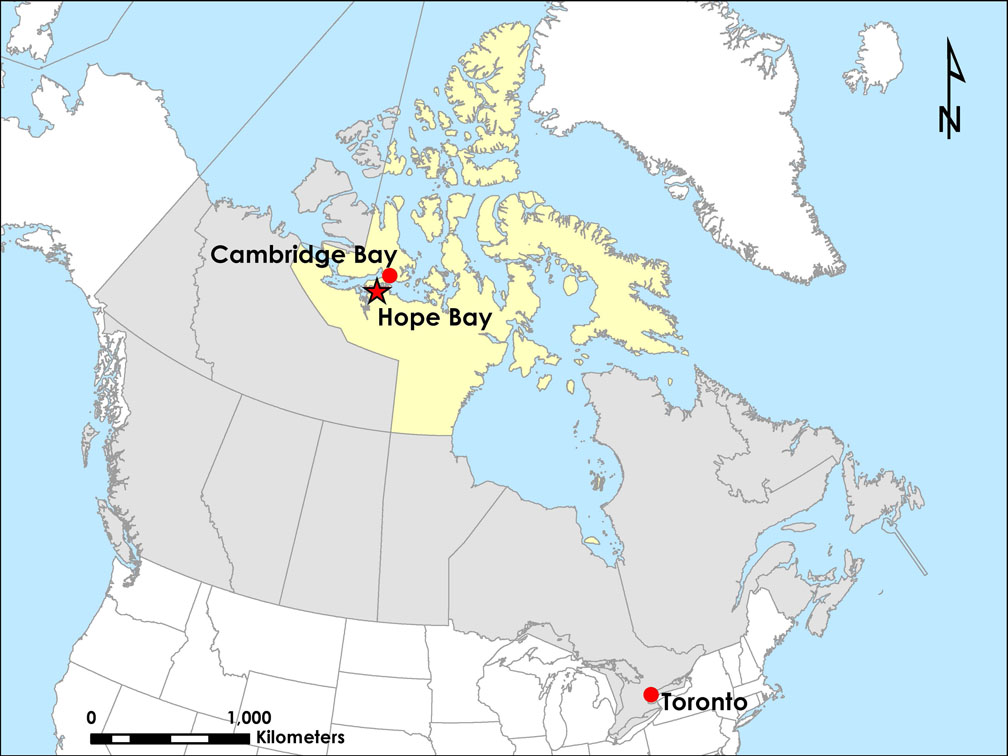Inuit org stays silent as Canada reviews the sale of an Arctic gold mine to a Chinese company
“It is in the hands of Investment Canada.”

The fate of the sale of TMAC Resources Inc. to Shandong Gold Mining Co. Ltd. may not be known until early in 2021.
SD Gold, a Chinese state-owned company, wants to buy TMAC, which owns western Nunavut’s Hope Bay gold mine, for $204.7 million.
Investment Canada was expected to release its review decision about the mine by the end of this year’s third quarter, that is, by the end of September.
But TMAC said in a regulatory update issued late Aug. 13 that the company now expects closing of the transaction to occur in the fourth quarter of 2020.
But “it may extend to the first quarter of 2021,” TMAC said.
Feb. 8 is the “extended outside date in the arrangement agreement at nine months post-announcement,” TMAC said in its update.
But until this decision is released, the Kitikmeot Inuit Association, which represents Inuit in western Nunavut’s five communities, is not saying whether or not it gave the federal agency a positive recommendation for the sale.
The KIA was among the minority shareholders that abstained from a shareholders’ vote in June, where the transaction was largely supported.
Contacted this week, Paul Emingak, the KIA’s executive director, said the organization had “no comments at this time” about the proposed sale: “It is in the hands of Investment Canada.”
In June, the KIA said it had been in discussions with SD Gold, but the company had not provided answers “in a timely manner.”
SD Gold has said it would, among other commitments, maintain contracting benefits to those serving Hope Bay, “including the continuity of existing significant contract business to local, Inuit-owned firms”; keep up the flow of royalties, fees and taxes to Inuit and territorial governments; and continue to grow Inuit employment at Hope Bay.
But the KIA said it planned to let the federal government know whether it would support the transaction on “the basis of it meeting KIA’s mandate and also on the basis of it being a net-benefit to Canada from the perspective of Kitikmeot Inuit,” KIA President Stanley Anablak said in a June 26 release.
In addition to its status as a minority shareholder, the KIA receives a smelter royalty of 1 percent of the value of all gold produced at Hope Bay.
The KIA also receives $1 million a year to offset land management, environment permitting and the implementation of the 20-year Inuit impact and benefits agreement it signed with TMAC in 2015.
Under the Investment Canada Act, the government will look at whether the deal with SD Gold is likely to increase employment in Canada, as well as its economic and other impacts.
The Investment Canada Act also allows Ottawa to review a transaction for national security reasons.
TMAC said the Minister of Innovation, Science and Industry extended the timeline to determine whether to initiate such a national security review until Oct. 19.
Until the government completes the federal review, the sale, approved by 97.08 percent of TMAC’s shareholders at a special meeting held in June, remains uncertain.
Some hurdles have been cleared. On June 30, TMAC received a final order from the Ontario Superior Court of Justice approving the sale to SD Gold.
As well, the Commissioner of Competition issued a “no action” letter and terminated the waiting period, a Competition Act approval requirement, early.
Both TMAC and SD Gold are committed to working towards the satisfaction of all closing conditions, TMAC said in July.
On May 8, TMAC first announced the completion of the strategic review process and its agreement with SD Gold to purchase all of the outstanding shares of TMAC at a price of $1.75 per share in cash.
If the deal with the Chinese state-owned company is a go, the Hope Bay mine would be able to ramp up to full operating levels, TMAC President and CEO Jason Neal has said.
TMAC began producing gold in early 2017 from Doris, its first mine at Hope Bay.
But during the past year, TMAC has dealt with disappointing production results and some challenges due to the COVID-19 pandemic
To help keep the new coronavirus out of Nunavut, TMAC sent its 60 or so Nunavut-based workers back home in March.
Recently, TMAC decided to purchase 2,000 Health Canada–authorized COVID-19 detection kits, along with swabs, tubes, personal protective equipment and lab time.
The tests are intended to reduce the risk of individuals with asymptomatic and latent infection with COVID-19 entering the workplace.
All of the testing items will be delivered directly to TMAC at its muster site in Edmonton.
“I am happy to report that we currently have no confirmed cases of COVID-19 at the Hope Bay site or any of the Company’s offices. We continue to monitor and evaluate the progression of the COVID-19 pandemic and its potential effects on our operations, liquidity and workforce at Hope Bay,” Neal said Aug. 13.